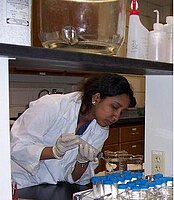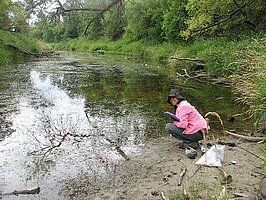Chemical Fingerprinting of Sediments and Water of the Souris River for Identification of Diffuse Pollution Sources

Dimuthu Wijeyaratne is a Graduate Student (PhD) in ECS (Environmental Conservation Science Program) in the North Dakota State University. She completed her B.S. in Zoology at the University of Kelaniya, Sri Lanka. Currently her research focuses on chemical fingerprinting of wetland sediments.
Dimuthu.Wijeyaratne@ndsu.edu
Fellow: Dimuthu Wijeyaratne
Advisor: Dr. Marinus Otte, Professor, Department of Biological Sciences, North Dakota State University
Matching Support: North Dakota State University
Degree Progress: PhD in Environmental Conservation Science Program expected in May 2010.
Chemical Fingerprinting of Sediments and Water of the Souris River for Identification of Diffuse Pollution Sources
Description of the project :
Sediments are a valuable source of information regarding the occurrence, magnitude and trend of human-associated environmental contaminants because they integrate erosion products from throughout the catchment area. Sediments consist of a large number of elements, many potentially contributing to water pollution. Sediment quality is an important environmental concern because sediments may act both as a sink and a source of constituents to the overlying water column and biota.
Chemical fingerprinting identifies the distribution of chemical elements within a matrix and thus defines its unique signature in comparison to similar matrices. It provides a sediment profile, which can then be used for direct sediment source tracing.
This project will consist of three major research tasks as follows:
Task 1 - determine the chemical fingerprint for the Souris River sediments by assessing the surface and depth variation in sediment signature
Task 2 - use the fingerprinting technique to identify sediment transport (source and sink sites) along the Souris River
Task 3 - apply the chemical fingerprinting technique to determine sources and sinks of P and other significant elements.
Project Objectives:
- To obtain a chemical fingerprint of sediments and water at selected sampling sites in the Souris River.
- To assess the concentration of phosphate in sediments and water at selected sites of the Souris River and identify potential sources of phosphate pollution.
- To assess the spatial variations in element concentrations in water and sediments and relate them to the land use patterns and phosphorous loading in the Souris River.
- To assess the biogeochemical behavior of elements in water and sediments of the selected areas of the Souris River.
- To geographically model the variation of the concentration of the elements along the Souris River.
- To geographically model potential sediment and associated pollutant sources along the Souris River.
Progress of the project:
In August 2008, sediment samples from the top layer of the riverbed were collected from small tributaries along the Upper Souris River. The samples were taken from inside tributaries, and from 50 m upstream and 50 m downstream in the Souris River. The homogenized sediment samples were acid digested and analyzed using a Spectro genesis ICP-OES for about 53 elements. The development of the fingerprints and statistical analysis of data for each site are in progress. The sediments were analyzed for the percentage organic matter content and particle sizes.
Research Outcomes:
Wijeyaratne D., Jacob D and Otte M April 2008. Chemical Fingerprinting of Sediments of the Souris River to assess the transport of phosphorous and other pollutants 5th Annual Northern Plains Biological Symposium, 2008. Fargo, ND. [Poster]
Significance of the project:
Chemical fingerprinting will provide a relatively low cost, rapid tool for sediment tracking, without the need for addition of exotic chemicals such radio-tracers or dyes to natural ecosystems. And at the successful completion of this project we will be able to identify sources and sinks of P and other pollutants in Souris River and their transport characteristics. Thereby we will be able to provide a baseline profile of P and large array of other elements in the Souris River.


Marinus Otte
Biological Sciences
Office: Stevens 121
Telephone: 701-231-8708
Email: marinus.otte@ndsu.edu


